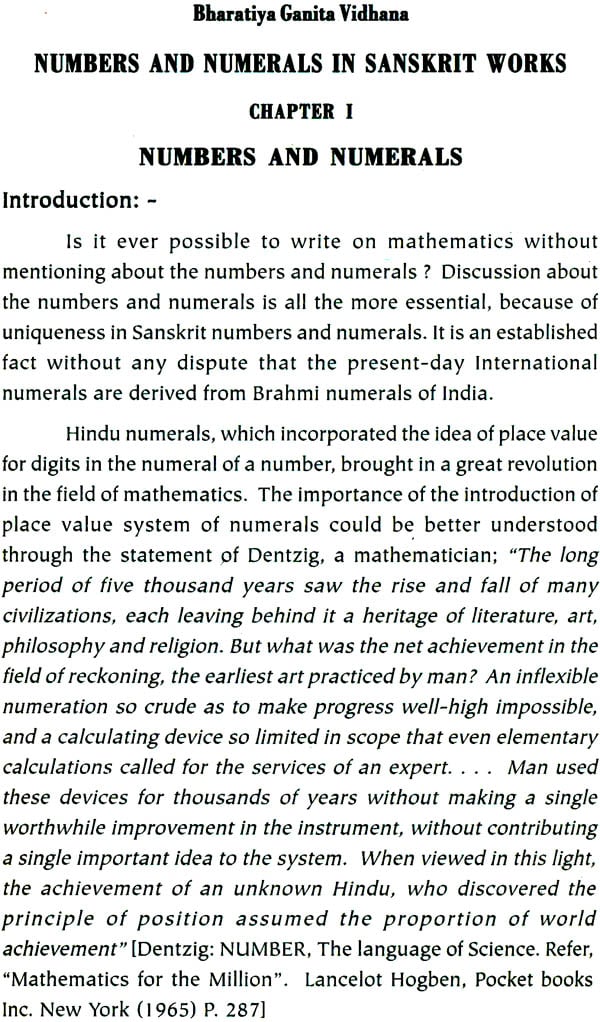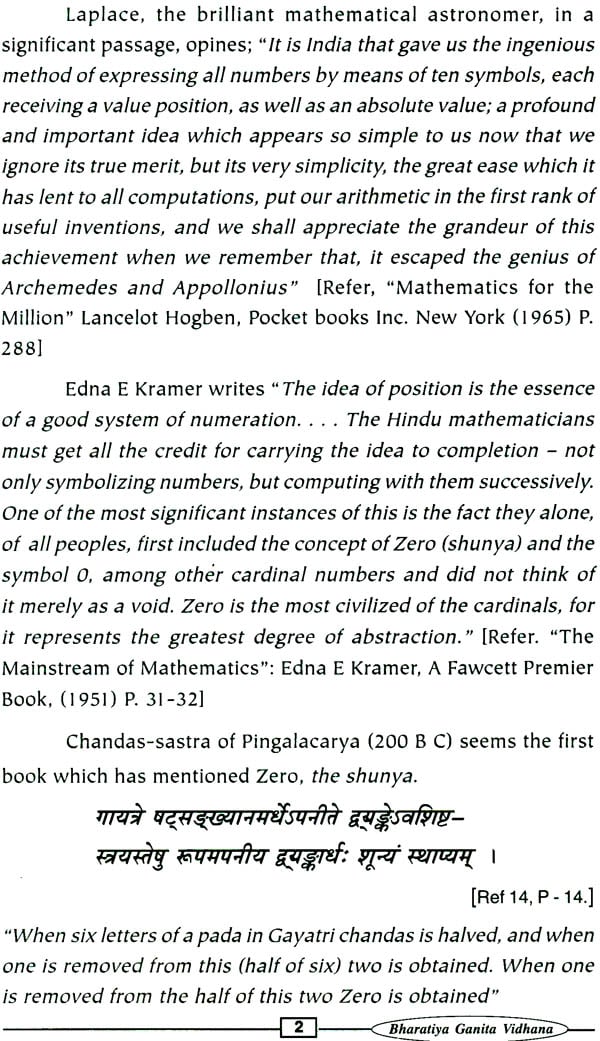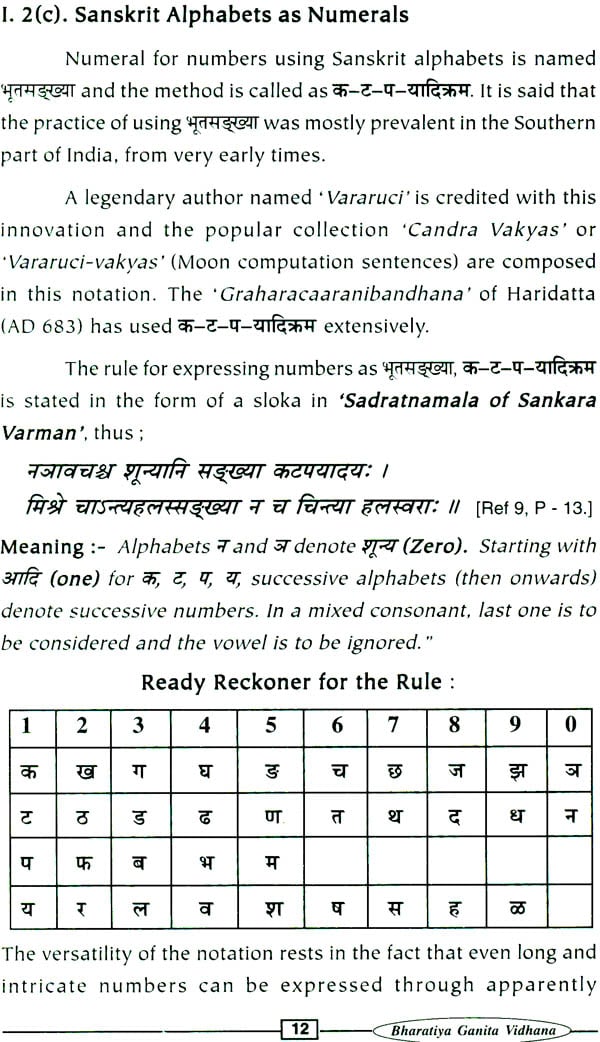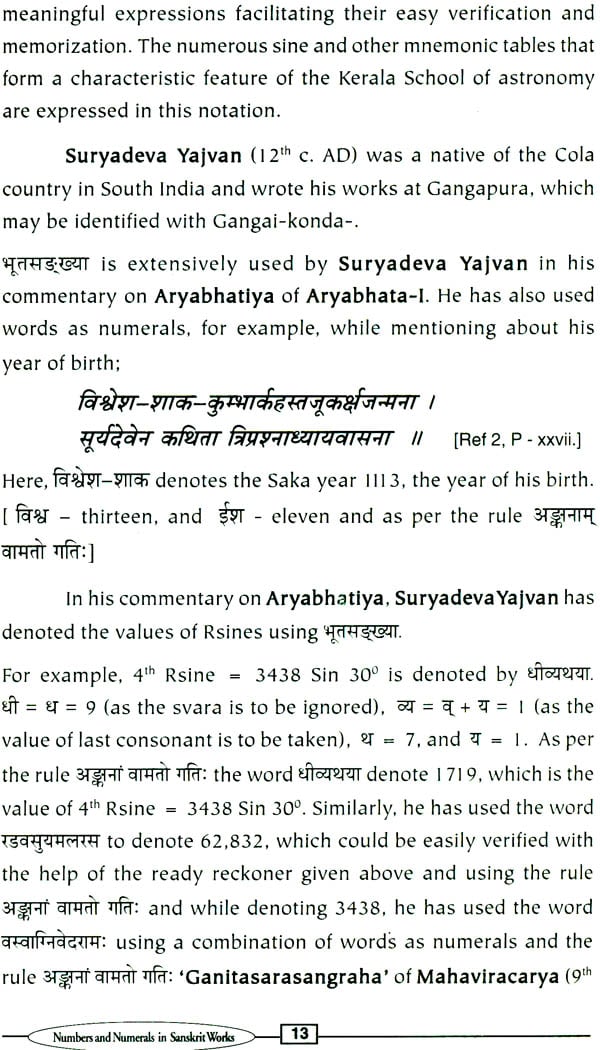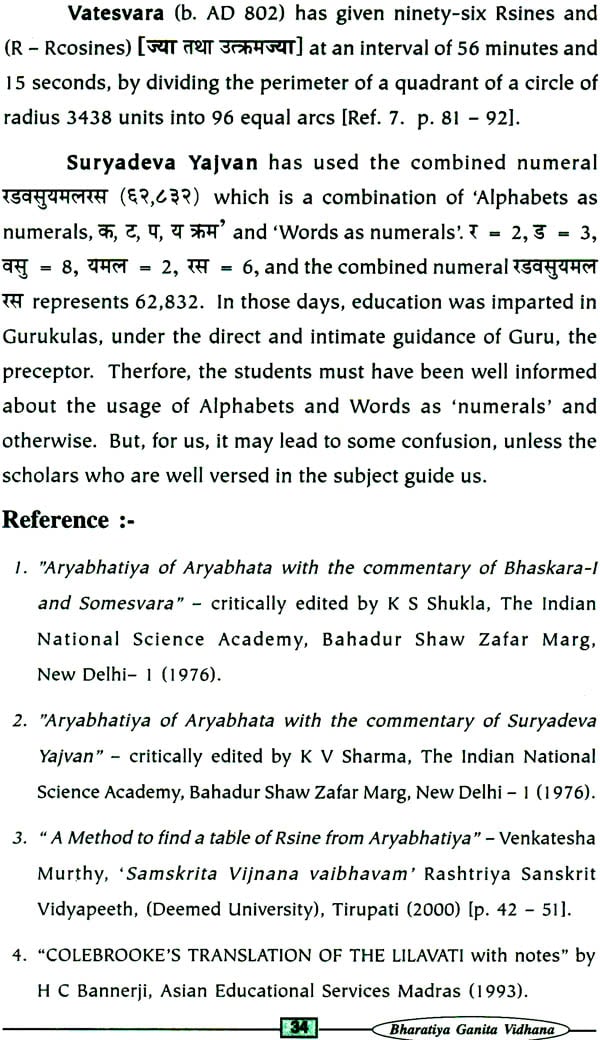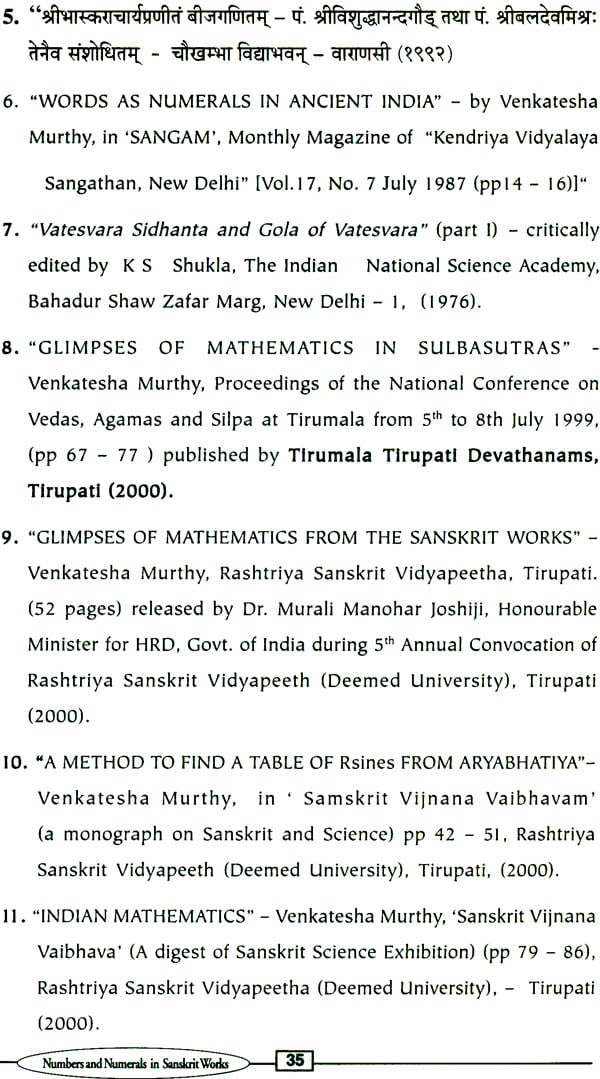
Numbers and Numerals in Sanskrit Works
Book Specification
| Item Code: | NAG972 |
| Author: | Venkatesha Murthy |
| Publisher: | Rashtriya Sanskrit Vidyapeetha, Tirupati |
| Language: | Sanskrit Text With English Translation |
| Edition: | 2003 |
| Pages: | 44 |
| Cover: | Paperback |
| Other Details | 9.0 inch X 5.5 inch |
| Weight | 80 gm |
Book Description
All the regions of human society beyond geographical limitations accept that Sanskrit is the main spring of a grand series of scientific disciplines in the ancient world and in the Indian peninsular. The disciplines like Mathematics, Physics, Chemistry, Botany, Metallurgy, Meteorology, Management etc., have their clean traces back in the ancient sanskrit literature. Hence emerged the new branch "Sanskrit-Science" with millennia's strength as a result of the uncessant efforts of modern knowledge seekers all over the world.
Knowledge of Sanskrit and perceptive analysis of scientific knowledge base presented by our Rishis and perceptive thinkers would be of great help in getting a good insight into our rich scientific heritage.
It is the responsibility of our institutions to arouse the interest of younger generations in sanskrit by unravelling the profound scientific wisdom that is contained in the sanskrit literature by demonstrating its glory and relavance to the modern world.
It is with this objective in view the Sanskrit-Science Study Centre of Rashtriya Sanskrit Vidyapeetha has taken initiative to launch a series of publication of small booklets which would cover a wide canvass of foresaid disciplines of sanskrit-science.
Dr. S. Balachndra Rao is Hon. Senior Fellow at the prestigious National Institute of Advanced Studies (NIAS), Bangalore. He worked for 35 years as a faculty in the Dept. of Mathematics at the National College, Basavanagudi, Bangalore and retired as Principal and Professor of Mathematics at that college.
Dr. Balachandra Rao's current field of interest is research in the field of tradition I Indian Astronomy. His books in the field: 1. Indian Mathematics and Astronomy - Some Landmarks, 2. Ancient Indian Astronomy- Planetary Positions and Eclipses, 3. Indian Astronomy- An Introduction and 4. Aryabhata - I and His Astronomy.
Dr. Rao has translated 1. Ganesh Daivajna's Grahalaghavam and 2. Bhaskara Charya's Karana Kutuhalam. 3. Currently he is translating Bhaskara's Bijaganitam.
It is now being increasingly recognized that ancient Sanskrit Literature contains profound wisdom of physical and social sciences. The scientific knowledge base presented by our Rishis and perceptive thinkers covers a wide canvas of subjects such as Physics, Chemistry, Mathematics, Astronomy, Metallurgy, Bio- Technology and Environmental Science etc.
Unfortunately, due to a very long period of intellectual domination of the forces from outside the region, we have lost our awareness about the profound contributions made by our ancestors that are hidden in the vast Sanskrit literature. Our continued apathy towards Sanskrit language over the recent centuries has also contributed to our lack of awareness about rich scientific heritage. Our ignorance about the richness of our heritage has made us to lose our sense of pride for what is ours. As a result of all this, our sense of confidence in our own capabilities has also been shaken.
Knowledge of Sanskrit and perceptive analysis of contents of our ancient Sanskrit literature would be of great help in getting a good insight into our rich scientific heritage. It is the responsibility of Sanskrit institutions to arouse the interests of the modern world in Sanskrit by unraveling the profound scientific wisdom that is contained in the Sanskrit literature and by demonstrating its relevance to the modern world. It is only when a link between the Sanskrit world and the modern world is established that the acceptability of Sanskrit as a relevant subject for dealing with the contemporary challenges of life would be enhanced.
It is with this object in view that the Rashtriya Sanskrit Vidyapeetha, Tirupati, launched a series of publication of small book-lets which cover wide convass of subjects such as Physics, Chemistry, Astronomy and Ayurveda etc. for the enlightenment of younger generations of India.
Prof. S. Balachandra Rao, who is profound scholar of Astronomy and Mathematics has prepared this booklet with his vast experience of teaching of Astronomy and conducting the seminars and workshops related to the subject. I congratulate him for preparing such a wonderful booklet.
I hope that this booklet would be found useful by students and scholars alike and inspire many students of Astronomy.
We feel immensely happy and proud to present this small booklet entitled Bhaskara -I and His Astronomy to the young readers who have a longing to have a glimpse of the wisdom of ancient India.
There is a general belief that contribution of ancient India is limited to the field of humanities particularly that of religion and phylosophy. Of course, no other civilization can claim superiority over what India has achieved in that area. Still if we go through the pages of this small book let, we will realize that in the area of Astronomy India's contribution was amazing. Now India has already lost much of its ancient lore due to the impact of foreign invasion. What remains also is largely unknown as most of it is in Sanskrit. Hence, we feel that there is an urgent need to save the remaining knowledge and build up awareness in all concerned especially among younger generations who are not aware of our ancient scientific heritage contained in Sanskrit.
Shouldering this responsibility i.e. creating the interests among the younger generations in Sanskrit by unravelling the profound scientific wisdom that is contained in the Sanskrit literature and demonstrating its relevance to the modern world, Rashtriya Sanskrit Vidyapeetha took the initiative of organising the Sanskrit Science exhibitions, publishing and propogating the Scientific literature of Sanskrit through out India.
I should mention at the out set that the inspiration to publish such booklets came from our Hon'ble Chancellor Dr. V.R. Panchamukhi, Economist of International fame, and versatile scholar in Sanskrit.
I would like to express my sincere thanks to Prof. S. Balachandra Rao for preparing this wonderful booklet.
If this small booklet kindles a tiny flame of desire in the hearts of young readers for studying the Sanskrit, the store house of past glory of India., we feel we would have been rewarded for our efforts.
The above verse shows the singular importance given to astronomy (and mathematics) over the other branches of knowledge in the Vedic times. In the Rgvedic rescension of the Yedanga Jyotisa (RVJ) the word jyotisam (astronomy) is used while in its place we find the word ganitam (mathematics) in the Yajurvedic rescension (YVJ).
The night sky filled with innumerable bright stars and planets, the "wanderers", has been the object of constant curiosity and excitement to man ever since the beginning of civilization. During the day, the rising Sun in the east and the setting Sun in the west, so also the periodically waxing and waning Moon at nights, drew the attention of the observer in man.
All these recurring phenomena as well as the annual repetitions of the seasons acquainted the early astronomers with their periodicity. In the course of time, further interesting phenomena like the solar and lunar eclipses, the visits of comets, etc., intrigued the astronomers to an even greater extent. And they began formulating the laws that govern these phenomena.
1. Ancient Indian Astronomy
Like many other branches of knowledge, the origins of the science of astronomy in India have to be traced back to the Vedas. In the Vedic lore, jyotisa is one of the six auxiliaries (saangas) of the Vedic corpus of knowledge. The six vedangas are: (i) Siksa (phonetics), (ii) Vyakarana (grammar), (iii) Chandas (metrics), (iv) Nirukta (etymology), (v) Jyotisa (astronomy) and (vi) Kalpa (rituals).
It is important to note that although in modern common parlance the word Jyotisa is used to mean predictive astrology, in the earlier literature Jyotisa included all aspects of astronomy. Of course, mathematics was regarded as a part of Jyotisa. Vedangajyotisa is the earliest Indian astronomical text available.
2. Vedic Period and Vedangajyotisa
The Vedangajyotisa was mainly used to fix suitable times for performing different kinds of sacrifices. The text is found in two rescensions Rgveda Jyotisa and Yajurveda Jyotisa. Though the contents of both the rescensions are the same, they differ in the number of verses. While the Rgvedic version contains only 36 verses, the Yajurvedic version contains 44 verses. This difference in the number of verses is perhaps due to the addition of explanatory verses by the adhvaryu priests by whom it was used.
| Chapter - I : | NUMERALS AND NUMBERS | |
| Introduction | 1 | |
| 1.1 The Place Value System | 3 | |
| 1.2 Numerals in Sanskrit Texts | 6 | |
| (a) Sanskrtt Words as Numerals | 7 | |
| (b) Compound Words as Numerals | 10 | |
| (i) A Rule for finding the Area of a circle from Lilavathi of Bhaskara - II | 11 | |
| (ii) A Rule for finding the Volume of a sphere from Lilavathi of Bhaskara - II | 11 | |
| (c) Sanskrit Alphabets as Numerals | 12 | |
| Chapter - II : | ARYABHATA NUMERALS | |
| (i)The Rule for using Aryabhatiya Numerals | 17 | |
| (ii) No. of Revolutions of Heavenly bodies in a Yuga | 19 | |
| (iii) Why Week days are named So ? A Reason from Aryabhatiya | 22 | |
| Chapter - III : | VALUE OF AND RSINES IN ARYABHATIYA OF ARYABHATA - I | |
| (a) Value of | 24 | |
| (b) A Method to find RSines | 27 | |
| (i) A Method to find Six RSines | 27 | |
| (ii) General Methods to find RSines | 29 | |
| (iii) To Find Twenty-four RSines | 30 | |
| REFERENCE | 34 |
